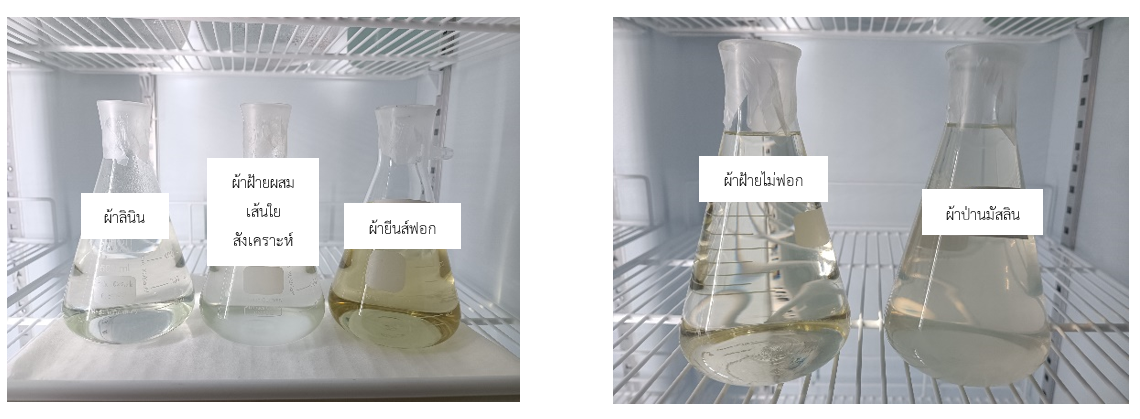การศึกษาเชิงปริมาณของสารประกอบ AOX ที่ตกค้างในผ้าที่มีส่วนผสมของเส้นใยธรรมชาติ ในประเทศไทย
DOI:
https://doi.org/10.60136/bas.v12.2023.645คำสำคัญ:
สารประกอบที่มีคลอรีนเป็นองค์ประกอบ, สารประกอบ AOX การสกัดจากผ้าบทคัดย่อ
AOX เป็นสารประกอบที่เกิดจากการทำปฏิกิริยาระหว่างลิกนินในเส้นใยธรรมชาติกับคลอรีนหรือสารประกอบคลอรีนในกระบวนการฟอก สารประกอบนี้มีความเสถียรสูง สลายตัวยาก มีความเป็นพิษ สามารถสะสมในสิ่งมีชีวิตได้ ทำให้เกิดความเสียหายในระดับพันธุกรรมทั้งในมนุษย์และสัตว์ ส่งผลเสียต่อการเจริญเติบโตของพืชและระบบต่อมไร้ท่อของสัตว์ การตรวจหาและลดปริมาณ AOX จึงเป็นประเด็นสำคัญ อุตสาหกรรมผ้าเป็นอุตสาหกรรมหนึ่งที่สามารถเกิดสารประกอบ AOX ได้จากขั้นตอนการฟอกผ้า ในหลายประเทศได้มีการกำหนดค่ามาตรฐานขั้นต่ำของปริมาณสารประกอบ AOX ในผลิตภัณฑ์ผ้าและน้ำเสียจากโรงงานผลิตผ้า แต่ในประเทศไทยไม่ได้มีการกำหนดค่ามาตรฐานไว้ งานวิจัยนี้จึงมีวัตถุประสงค์ที่จะศึกษาและเปรียบเทียบปริมาณสารประกอบ AOX ที่ตกค้างในตัวอย่างผ้าที่มีส่วนผสมของเส้นใยธรรมชาติที่เป็นที่นิยมใช้และมีขายทั่วไปในท้องตลาดภายในประเทศ จำนวน 6 ชนิด ประกอบด้วย ผ้าฝ้ายไม่ฟอก ผ้าฝ้ายฟอกขาว ผ้ายีนส์ฟอก ผ้าลินิน ผ้าป่านมัสลิน ผ้าฝ้ายผสมเส้นใยสังเคราะห์พอลิเอสเทอร์ โดยใช้วิธีการสกัดสารด้วยซอกห์เลต (Soxhlet extraction) โดยใช้น้ำเป็นตัวทำละลาย และหาปริมาณสารประกอบ AOX ตามวิธีทดสอบมาตรฐาน ISO 9562 จากการศึกษาพบว่าผ้าทั้ง 6 ชนิด มีสารประกอบ AOX โดยผ้าฝ้ายฟอกขาวมีปริมาณสารประกอบ AOX ตกค้างมากที่สุดเท่ากับ 56.34 มิลลิกรัมต่อกิโลกรัมของผ้าแห้ง และผ้าฝ้ายผสมใยสังเคราะห์มีปริมาณสารประกอบ AOX น้อยที่สุดเท่ากับ 7.73 มิลลิกรัมต่อกิโลกรัมของผ้าแห้ง เมื่อเทียบปริมาณสารประกอบ AOX ที่ตกค้างในผ้ากับเกณฑ์ที่ Global Organic Textile Standard (GOTS) กำหนด พบว่า ปริมาณสารประกอบ AOX ที่ตกค้างในผ้าทั้ง 6 ชนิดมีค่าสูงกว่าเกณฑ์ซึ่งกำหนดไว้ไม่เกิน 5.00 มิลลิกรัมต่อกิโลกรัมผ้าแห้ง
References
Maria WM, Wiśniowska E. Halogenated organic compounds in water and in wastewater. Civ Environ Eng Rep. 2019;29(4):236-47. doi: 10.2478/ceer-2019-0057.
Shi L, Ge J, Zhang F, Nie S, Qin C, Yao S. Difference in adsorbable organic halogen formation between phenolic and non-phenolic lignin model compounds in chlorine dioxide bleaching. R Soc Open Sci. 2019;6(10):191202. doi: 10.1098/rsos.191202.
Shi L, Ge J, Nie S, Qin C, Yao S. Effect of lignin structure on adsorbable organic halogens formation in chlorine dioxide bleaching. R Soc Open Sci. 2019;6(2):1-10. doi: 10.1098/rsos.182024
Yao S, Gao C, Jiang L, Nie S, Wang S, Qin C. Research on the formation mechanism of absorbable organic halogen during the alkali extraction stage of eucalyptus kraft pulp. J Biobased Mater Bioenergy [Internet]. 2017 [cited 2023 May 9];11(5):461-5. Available from: https://doi.org/10.1166/jbmb.2017.1704
สำนักงานมาตรฐานผลิตภััณฑ์อุุตสาหกรรม, สถาบันสิ่่งแวดล้อมไทย, สำนักงานเลขานุุการโครงการฉลากเขียว. ข้อกำหนดฉลากเขียวผลิตภัณฑ์กระดาษ: กระดาษพิมพ์และเขียน (Printing and writing paper). TGL-8/1-15. กรุุงเทพฯ: สำนักงานมาตรฐานผลิตภัณฑ์อุุตสาหกรรม; 2558.
Leri AC, Anthony LN. Formation of organochlorine by-products in bleached laundry. Chemosphere. 2013;90(6):2041-9. doi: 10.1016/j.chemosphere.2012.10.088.
Leverette MM. 6 Chlorine bleach tips for better laundry results [Internet]. 2022 [cited 2023 May9]. Available from: https://www.thespruce.com/better-laundry-results-with-chlorine-bleach-2145786
Bluesign Technology. Bluesign® criteria for production sites annex: textile manufacturer version. 3.0. Moevenstrasse: Bluesign technology; 2020 [cited 2023 May 9]. Available from: https://www.bluesign.com/downloads/criteria-2020/annex_textile_manufacturer_v3.0_2020-03.pdf
Global Standard gemeinnutzige GmbH. Global organic textile standard (GOTS) version 6.0 [Internet] 2020 [cited 2023 May 9]. Available from: https://global-standard.org/images/resourcelibrary/documents/standard-and-manual/gots_version_6_0_en1.pdf
International Association of Natural Textile Industry. Naturtexil IVN certified BEST (IVN BEST)[Internet]. 2018 [cited 2023 May 9]. Available from: https://naturtextil.de/wp-content/uploads/2020/08/Richtlinie_IVN_Best_6_1_English_2018_08_01.pdf
Ministry of Commercze and Industry, Department of Commerce, National Programme for OrganicProduction. Indian standards for organic textiles (ISOT) [Internet]. [cited 2023 May 9]. Availablefrom: https://www.apeda.gov.in/apedawebsite/organic/ISOT_Textiles_Standard.pdf
Sweden Textile Water Initiative. Guildelines for sustainable water use in the production andmanufactoring processes of textiles [Internet]. 2014 [cited 2023 May 9]. Available from: https://corporate.bjornborg.com/en/wp-content/uploads/sites/2/2016/07/Sweden-Textile-Water-Initiative-Guidelines.pdf
5 ชนิดที่มีบทบาทที่สุดในโลกของเสื้อผ้า [อินเทอร์เน็ต]. 2564 [เข้าถึงเมื่อ 28 สิงหาคม 2566]. เข้าถึงได้จาก: https://www.teppsimply.com/content/25717/5-ชนิดที่มีบทบาทที่สุดในโลกของเสื้อผ้า
7 ผ้าที่นิยมใช้ในงานแฟชั่น [อินเทอร์เน็ต]. 2563 [เข้าถึงเมื่อ 28 สิงหาคม 2566]. เข้าถึงได้จาก: https://www.winnaargarment.com/content/5505/7-ผ้าที่นิยมใช้ในงานแฟชั่น-summer
Dehabadi L, Karoyo AH, Soleimani M, Alabi WO, Simonson CJ, Wilson LD. Flax biomass conversion via controlled oxidation: Facile tuning of physicochemical properties. Bioeng [Internet]. 2020 [cited 2023 May 9];7(2):38. Available from: https://doi.org/10.3390/bioengineering7020038
MacMillan C, Birke H, Bedon F, Pettolino F. Lignin deposition in cotton cells-Where is the lignin?.J Plant Biochem Physiol [Internet]. 2016 [cited 2023 May 9];1(2):1000e106. Available from:https://doi.org/10.4172/2329-9029.1000e106
Chen X, Zhang K, Xiao LP, Sun RC, Song G. Total utilization of lignin and carbohydrates ineucalyptus grandis: An integrated biorefinery strategy towards phenolics, levulinic acid, and furfural. Biotechnol Biofuels [Internet]. 2020 [cited 2023 May 9];13(2). Available from: https://doi.org/10.1186/s13068-019-1644-z

Downloads
เผยแพร่แล้ว
How to Cite
ฉบับ
บท
License
Copyright (c) 2023 กรมวิทยาศาสตร์บริการ

This work is licensed under a Creative Commons Attribution-NonCommercial 4.0 International License.








